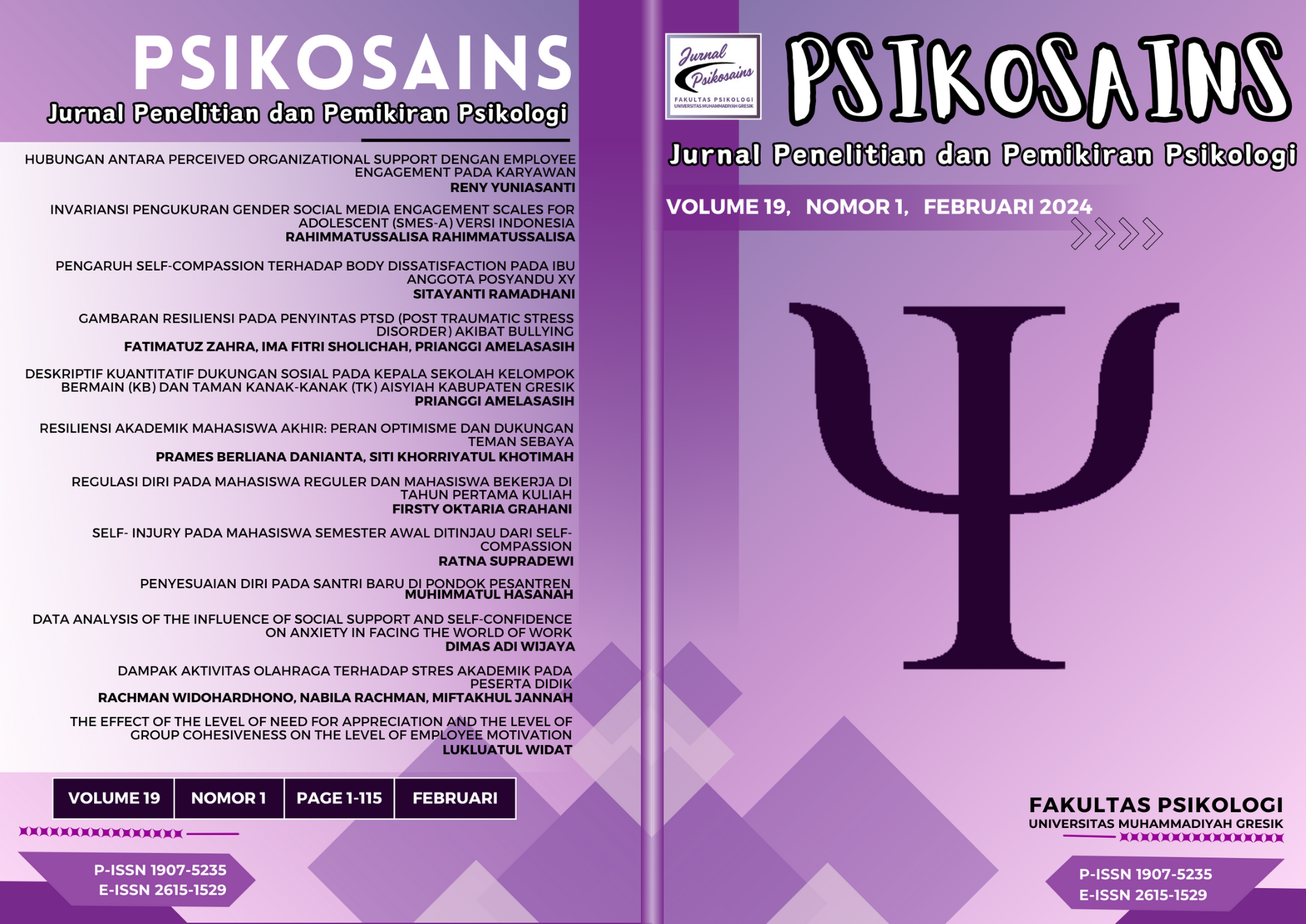SELF- INJURY PADA MAHASISWA SEMESTER AWAL DITINJAU DARI SELF-COMPASSION
DOI:
https://doi.org/10.30587/psikosains.v19i1.7225Keywords:
first semester student, sel-injury, sel-compassion.Abstract
Objective: This research aims to examine empirically whether there is a
relationship between self-compassion and self-injury in first semester students,
Faculty of Psychology, Unissula Semarang. Method: This research is
quantitative using correlational methods. The research subjects were 88 first
semester students consisting of 72 women and 16 men. The subject sampling
technique used purposive sampling. This research data was collected using two
scales. The self-injury scale from Fiqria (2018) has an alpha reliability of 0.950,
and the self-compassion scale from Susanti (2019) which has an alpha reliability
of 0.920. Result: Research data analysis used non-parametric Spearman
correlation, because the data distribution did not normal. The result obtained a
correlation coefficient of -0.437, and a significance level of 0.000 (p < 0.05)
using Spearman's rho correlation. This correlation is stated to be quite strong
(0.26 – 0.50 quite strong correlation category). Conclusion: It can be concluded
that the hypothesis is accepted, that there is a significant negative relationship
between self-compassion and self-injury. The higher the student's self-
compassion, the lower the student's self-injury, and vice versa.
References
Sciences, 2 (3), 702 – 718.
Allen, A.B., & Leary, M.R. (2010). Self-compasion, stres, and coping. Social and Personality
Psychology Compass, 4,107-108.
Arnett.,J.J.(2015). Emerging adulthood : the window road from the late teens through the twenties.
2nd edition. New York : Oxford University Press.
Barnard, L.K., & Curry, J.F. (2011). Self-compassion : Conceptualizations, correlates, &
intervention. Review of General Psychology, 15, 289-303.
Bluth,K., Robertson, P.N., Gaylord,S.A., Faurot, K.R., Grewen, K.M., ArzonS., & Girdler S.S.
(2016). Does self-compassion protect adolescents from stress? Journal of Child and Family
Studies, 25, 1098-1109.
Bresin, K. & Schoenieber, M. (2015). Gender differences in the prevalence of nonsuicidal self-injury
: A meta-analysis. Clinical Psychology Review, 3, 167 – 183.
Bruffaerts, R., Mortier, P., Kiekens,G., Auerbach,R.P., Cuijpers,P., Demyttenaere, K. (2018). Mental
health problem in college freshmen : prevalence and academic functioning. Journal Affect
Disorder, 225 (2),97-103.
Claes, L., De Raedt, R., Van de Walle, M., & Bosmans, G. ( 2016) Attentional bias moderates the
link between attachment-related expectations and non suicidal.self-injury. Cognitive Therapy
and Research, 40, 540-548.
Fiqria, P.M. (2018) Hubungan antara regulasi emosi dengan kecenderungan self-injury pada
mahasiswa Universitas Islam Sultan Agung Semarang. Skripsi : Tidak diterbitkan.
Hadi, S. (2003). Metodologi Research. Yogyakarta : Pustaka Andi.
Humphreys, K., Risner, W., Hicks, J., & Mayer, M. (2015). Non-suicidal self- injury: Cutting through
the pain. Atlanta (Manuskript).
Kanan, L. M., Finger, J., & Plog, A. E. (2008). Self-injury and youth: Best practices for school
intervention. School Psychology Forum: Research in Practice, 2(2),67-69.
Knigge, J. (1999). Self Injury for Teacers. Article of Self Injury. Kettewell.
Lloyd-Richardson, E. E., Perrine, N., Dierker, L., & Kelley, M. L. (2007). Characteristics and
functions of non-suicidal self-injury in a community sample of adolescents. Psychological
Medicine, 37(8), 1183.
MacBeth, A., & Gumley, A. (2012). Exploring compassion : A meta-analysis of the association
between self-compassion and psychopathology.Clinical Psychological Review, 32, 545-552.
Muthia, E. N. (2015). Kesepian dan keinginan melukai diri sendiri pada remaja. Universitas
Muhammadiyah Malang. Skripsi : Tidak diterbitkan.
Neff, K.D. (2003). Self compassion : an alternative conceptualization of a healthy attitude toward
oneself. Self and Identity, 2, 85 -101.
Neff, K.D. (2016). The self-compassion scale is a valid and theoterically coherent measure of self-
compassion. Mindfullness, 7, 264 -274.
Nock, M. K., Prinstein, M. J., & Sterba, S. K. (2010). Revealing the form and function of self-injurious
thoughts and behaviors: A real-time ecological assessment study among adolescents and young
adults. Journal of Abnormal Psychology, 118(4), 816.
Susanti, A. (2019).Hubungan antara self-compassion dan loneliness pada remaja.Fakultas Pendidikan
Universitas Negeri Jakarta. Skripsi : Tidak diterbitkan.
Walsh, B. (2007). Clinical assessment of self‐injury: A practical guide. Journal of Clinical
Psychology, 63(11), 1057–1068.
Whitlock, J. (2009). The cutting edge: Non-suicidal self-injury in adolescence.Research Facts and
Findings. Online Verfügbar Unter: Http://Www. Actforyouth.
Net/Resources/Rf/Rf_nssi_1209. Pdf, Stand, 3, 2012.
Whitlock, J. L., Powers, J. L., & Eckenrode, J. (2006). The virtual cutting edge: the internet and
adolescent self-injury. Developmental Psychology, 42(3), 407.



